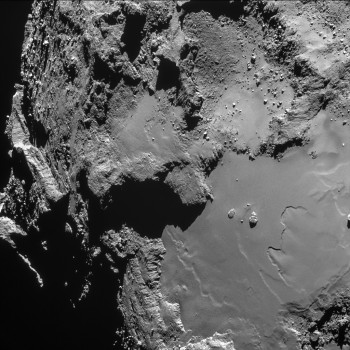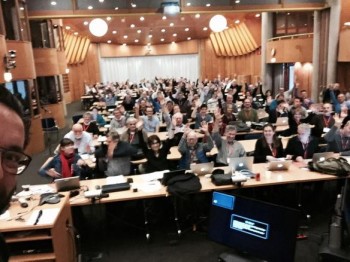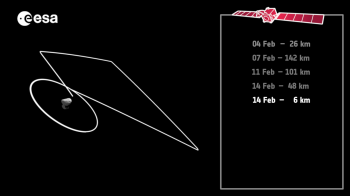US Rosetta Project Scientist Claudia Alexander and ESA’s Rosetta Project Scientist Matt Taylor report on the discussions held at the recent Rosetta Science Working Team meeting.
The Rosetta Science Working Team (SWT) met for the 40th time earlier this month, this time at ESTEC in Noordwijk, Netherlands. This meeting was attended by principal investigators and co-investigators of the instruments and other researchers but also science operations personnel and staff from the mission operations team. This week the main topics discussed were the science of the mission so far, science operations and new trajectories going forward, and updates on the state of the health of the experiments and the spacecraft.
Compared to our predictions and expectations, the activity of the comet is slightly lower than expected and this was one of the main points of discussion at this SWT. The impact is that this means we could potentially be flying the spacecraft closer to the comet. However, given the overall constraints on flight around the comet, there are only a few things that can be changed in the short term. After the landing in November 2014, we’ve performed many terminator orbits (terminator is the line dividing day and night), and those have included circular orbits – what we call ‘bound’ orbits, where the spacecraft is gravitationally bound to the comet, the way a normal orbit around any other planetary object is done.
We have stayed away from more active areas of the comet in general, so there is also some concern that we might have just sampled the region of the comet that is expected to be of lower activity. However, most recently we have started flying farther away from the comet, as the period for doing bound orbits disappeared, and swooping closer in a series of fly-bys. For example, the past four weeks included:
- On 14 February, Rosetta flew as close as 6 km above the nucleus (through the sub-solar point!)
- Following the close fly-by, Rosetta flew as far away as 250 km
- A subsequent fly-by where Rosetta passed through the sub-solar point again, but this time at a minimum distance of 53 km
Since a comet has so little gravity, a critical issue for navigating around it is when the gas and dust of the comet becomes so profuse that it starts to drag on the surfaces of the spacecraft and balance out the forces of gravity. Previously, the navigation team at the Rosetta Mission Operations Center (RMOC) considered the comet would be so active that the drag forces would become significant, and prevent ‘bound’ orbits after about the middle of February. The trajectories of the mission are designed using long term predictions to facilitate scientific operations but mean changes in the short term are not possible. Recently however, following a request from the science working team, the navigation team came up with a new scheme that takes advantage of the experience we have had in the terminator orbits. The proposed trajectories are designed to simply remain as close as possible to the comet which is great for some science observations, but at the same time also preclude exploration at different phase angle (angle of sunlight illumination), as the comet changes seasons from northern hemisphere summer to southern summer, which restricts other science.

Single frame NAVCAM image taken at 16:12 UT on 14 February. Credits: ESA/Rosetta/NAVCAM – CC BY-SA IGO 3.0
Additional ‘phase angle coverage’ is useful to scientists studying a surface under different lighting conditions in the same way that a landscape artist, or photographer, studies a subject under different lighting conditions. Consider the classic English landscape artist John Constable, who used to study farms and/or mills at length, at different times of day, prior to finalizing a landscape (see the Tate Museum Constable exhibit for examples). Different lighting conditions (including those at ultraviolet and infrared wavelengths), bring out different features in terrain/foliage etc, as the reflectivity of any surface changes. It’s the reflectivity that is associated with different properties of the material the surface is made of, so seeing a surface under different conditions of light helps to define what those reflectivity properties are.
The ability to get really close to the comet nucleus for long periods of time allows those instruments that collect samples within an aperture to sample even more primitive material. The new scheme would enhance the ability of in situ instruments to gain signal as the spacecraft dipped closer, but the ability to study the nucleus under changing lighting conditions (particularly when the southern hemisphere starts to be exposed in southern summer) would be reduced. The SWT discussed the proposal at length and concluded that an approach in which terminator orbits are combined with those that can study lower phase orbits is the best compromise.
Observing 67P/C-G from Earth
As part of the SWT week, splinter workshops included that of the ground-based observing campaign, let by Colin Snodgrass, a UK cometary scientist at the Open University who leads (along with colleagues at ESO) the professional ground based campaign group (https://www.rosetta-campaign.net). Both amateurs and professionals are welcome to the meeting. The comet is currently behind the Sun, and will not be visible to professional ground-based observers until about June 2015 (just before perihelion). It is the hope that amateur astronomers will be able to observe the comet starting in the April-May timeframe. The US Rosetta Project manages the amateur ground-based observing program on behalf of the project. A new website is being designed, with a welcome page for amateur astronomers who are interested in participating in this exciting campaign. Web pages will soon* be introduced at the JPL Rosetta web site, and a form for amateurs to fill out to register for the program. Instructions for how amateurs can upload (FITS Format) pictures will be included in a hand-book at that time.
An overall description of the observing campaign can be found here: https://www.rosetta-campaign.net. A schedule for dates and times of official ground-based telescope campaigns for Rosetta can be found here https://www.rosetta-campaign.net/planned-observations.
*Ed’s note, 24 March: the JPL pages for the amateur ground-based observing program are now online here: https://rosetta.jpl.nasa.gov/rosetta-ground-based-campaign











Discussion: 17 comments
Can you help me confirm something?
I’d like to verify that we are only a couple days away from the latest possible date for 6 months worth of raw post-hibernation OSIRIS data to be made publicly available in the archives.
We were told in June 2014:
“All Rosetta science instrument data have a proprietary period of 6 months, after which they will be publicly available in our archives” ( https://blogs.esa.int/rosetta/2014/06/25/comet-67pc-g-in-rosettas-navigation-camera/ )
This was confirmed in July 2014:
“With Rosetta, all data from its 21 instruments (11 on the orbiter, 10 on the Philae lander) are subject to a 6 month proprietary period.” ( https://blogs.esa.int/rosetta/2014/07/16/access-to-rosetta-data/ )
Two months ago, I inquired about why the archives ( ftp://psa.esac.esa.int/pub/mirror/INTERNATIONAL-ROSETTA-MISSION/ ) didn’t yet contain any post-hibernation OSIRIS data, despite the instrument having been returning data for over 9 months. ( https://blogs.esa.int/rosetta/2015/01/12/cometwatch-6-january/#comment-322770 )
I was told, at that time, that “the release of science data that is on a six-month proprietary period is made six months after the end of the previous six month period”, meaning that 6 months was actually the *earliest* we could see data released, and that the actual longest time there could be from acquisition to release was 12 (6 + 6) months, and that the release would contain all of the data from 12 months prior to the release, up to 6 months prior to release (so, a six month chunk of data, ending 6 months before it had to be released). I was a litte disappointed to find out the wait time was really about 9 (+/- 3) months rather than 6, but at least I’d been informed of the real maximum delay (12 months), so it didn’t really bother me.
I know OSIRIS resumed producing data at least as early as 20 March 2014 (a couple days short of a year ago) based on a press release from Max Planck about OSIRIS ( https://www.mps.mpg.de/3323535/PM_2014_03_27_Rosetta_A_glimpse_of_the_comet ) that says “This image taken with the Wide Angle Camera on March 20 shows a wide field 25 times larger than the diameter of the full moon.”
I also know post-hibernation OSIRIS data has not been included in any data release so far, and given that post-hibernation OSIRIS data has been accumulating since at least one year (minus a couple days) ago, I can conclude that the latest the first 6-month batch of post-hibernation data would be released is 20 March 2015 (or earlier, if OSIRIS resumed returning data earlier than 20 March 2014). Additionally, I can conclude that the OSIRIS team hasn’t opted for a release cycle smaller than 6 months (if they had, then the first set of post-hibernation OSIRIS data would have already been released), therefore the imminent data release, a couple days from now at the latest, must be a release that includes 6 months worth of OSIRIS data.
I don’t believe I’ve made any mathematical errors, so that should be correct. Would you be kind enough to confirm that this is correct, and that we should be seeing all raw OSIRIS data from 20 March 2014 through 20 September 2014 released in the archive by the end of this week? Or will it take a couple days to get the data into the archive, so we might not see it until next week?
Thanks 🙂
Hi, First, sorry for the delay in approving your post – I was working on finding the answer, but posting it here seems like a better place in the end 🙂
So, to clarify, building on my answer to you on 14 January, the next set of scientific data to be released will be from the post-hibernation phase up until the end of Philae’s post-landing activities and Rosetta’s post-separation manoeuvres on 19 November. Following the convention outlined previously, delivery of the data from the instrument teams to ESA is due six months after the end of that period, so in this case, the date is 19 May 2015, with deliveries to be expected then or very soon after from the teams. These are then validated and placed into the archive for public access, hopefully within a week or so. The next block of data, corresponding to ‘escort phase 1’ from 19 November to 10 March, should be delivered to ESA on 10 September.
We will provide more information in a future blog post on how the archiving process is to be carried out by the Rosetta downlink and archive team.
Hope that helps!
Emily
Good.
I suggest ESA officials to read carefully the agreement on data release with Holder S. They might find that the 6-month period is counted in comet-years 😉
More useful would be to know about the next data set. How long are the subsequent observation periods, or is it more like release 6 month after the individual observation after some point?
What about Philae data?
Oh, I thought you’d said the release of science data that is on a six-month proprietary period is made six months after the end of the previous six month period. Releasing everything post-hibernation all the way up to 19 November 2014 at the same time is releasing 10 months of data 6 months after the end of a *10* month period, so the earliest data will be released 16 months after the teams started working with it. But then, the next release you mention is only 4 months of data released 6 months after the end of a *4* month period. It seems I misinterpreted your previous response when I took it to mean that both the data period and the proprietary period were each 6 months. So really, it’s just however they choose to group it. For example, if they had decided to group all of the science to do with 67P in a single chunk, they would have been able to keep all of the data to themselves until June 2016, six months after the end of the mission.
I believe I understand now, and yes, you’ve been very helpful. Thank you. 🙂
Could we get diagrams of the Rosetta trajectory plan? Thanks!
Will see if this info is available…!
It’s amazing really. Here we sit drinking coffee while looking at pictures of a comet taken from 6-10 km away….. You just gotta love the age we live in!
– coffee makes the world go round.
As anxious as I am to see the OSIRIS images, I’m most interested in the science. I can really see the point of view of the people doing the real work. Not having to work under any more pressure than necessary allows them to take the time it takes to do really, truly excellent science.
I’ve worked in software for several companies that could afford to do that, and they were good places to work.
I’ve worked for one company that was operating “on Internet time” — a release every six months, with major new features and all the interpersonal stress that comes with high pressure, and it was gruelling. I was in the testing department and you just try doing a proper test cycle when they’ve already pushed the schedule trying to squeeze in those last couple features that HAVE to go out the door. GAAAH.
I want better science than that, personally, so I’m fine with waiting for the data. It’ll keep.
I do enjoy Holger Seirks’ dry wit. For example, on looking for Philae: “….we have identified several sets of three spots.” I’m still chortling about that one.
Not to mention, in the Science article — “consolidated cometary material” — HA! I translate that to “ok, guys, science takes a long, long, long time to do right, and this is the state of the science of the composition of the comet at this moment: parts of it are consolidated. The bounce told us that pretty conclusively, no arguing with that.” A good cautious scientific attitude to take, never mind all the public “tell us NOW, tell us NOW” or the even more annoying attitude of “they actually KNOW, they’re just not telling us yet for some nefarious purpose of their own.”
Science takes a long time. I’m behind that.
Judy
Ha, Judy, well-put.
As much as I’d love to get my hooks into more of the OSIRIS imagery, ain’t gonna happen soon, especially with the Dog-Eat-Dog World of Publish-or-Perish Academia. I’m happy with the scrap NavCam puzzle-pieces.
And we have gotten so accustomed to the almost orchestrated data releases of a few recent missions that we’ve forgotten being thrilled with Facsimile-quality newspaper halftone images of the early ’60’s Mars Mariner missions.
I’m going to kick back and marvel over the Rosetta images we got today whilst sipping a nice cup of hot chocolate….
–Bill
I very much agree with you Judith.
The obsession with getting hold of the data before it is ready is really rather ridiculous, especially as it is not easy for the general public to do anything significant with it.
That said, I do think the release policy on OSIRIS images has been overly slow and restrictive – not for scientific reasons, but for public engagement with science, and public support for spending tax money on it.
ESA has patched this up, very sensibly, with NAVCAM images. But I’m firmly of the view that there would have been benefit for future support for science in a better, quicker release of, in particular, OSIRIS pictures, and more good exciting snapshots of what has been seen scientifically. I do not believe this would have harmed the eventual publications, or the careers of those involved at all, if done sensibly.
I agree with Herobrine:
it is clear that OSIRIS team took a number of excuses to
justify the embargo of OSIRIS pictures up to geological time.
It is clear that the six months delay means six months after the end of the mission (I hope Rosetta mission…).
In any case the public interest in OSIRIS pictures is now (and for the future) totally run-down.
In this situation no problems even if the delay in the release of the OSIRIS pictures should take many years.
Humbly asking University Teams and People of the Bridge to consider magnetic axis terminator orbits.
If you’re bringing Rosetta closer to the comet because the nucleus is less active than predicted (because heat is not the significant factor) then be careful when a CME is released towards 67P. The increased ion density will cause a “flare-up” and be potentially devastating to Rosetta.
We have the prediction that large changes will be caused during the perihelion passage in the southern hemisphere. To measure the changes it would be good to have lots of pictures and accurate maps. But since this part is coming into view only now, is a mapping being performed now?
I noticed on “where is Rosetta” that 67P/C-G is now under 2 AU from the Sun. Since its perihelion is around 1.25 AU, that means we can expect a factor of about (2/1.25) squared increase in the radiation intensity. Does this give an estimate of the approximate temperature the surface directly under the Sun will face?
Correction: the ephemeris seems to say it will be under 2 AU tomorrow!
Kamal